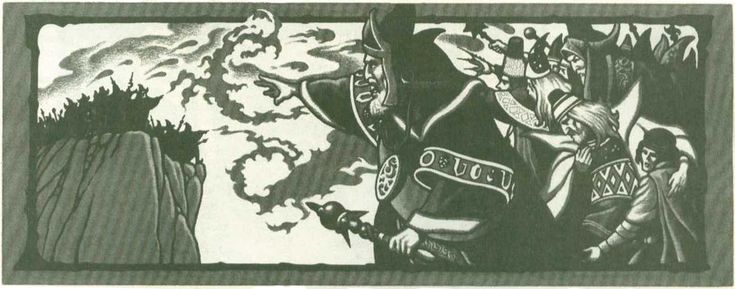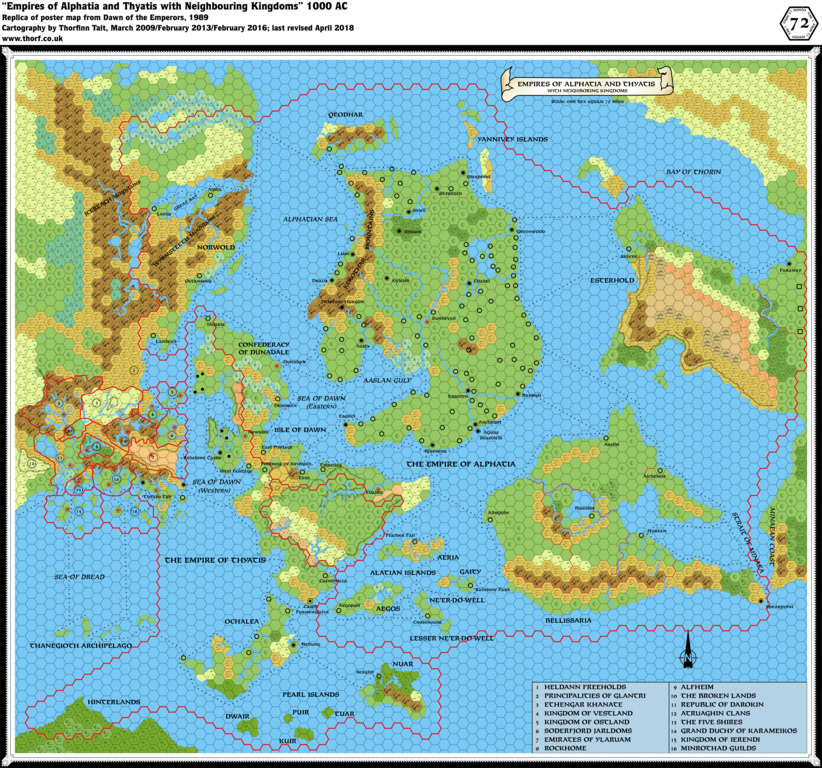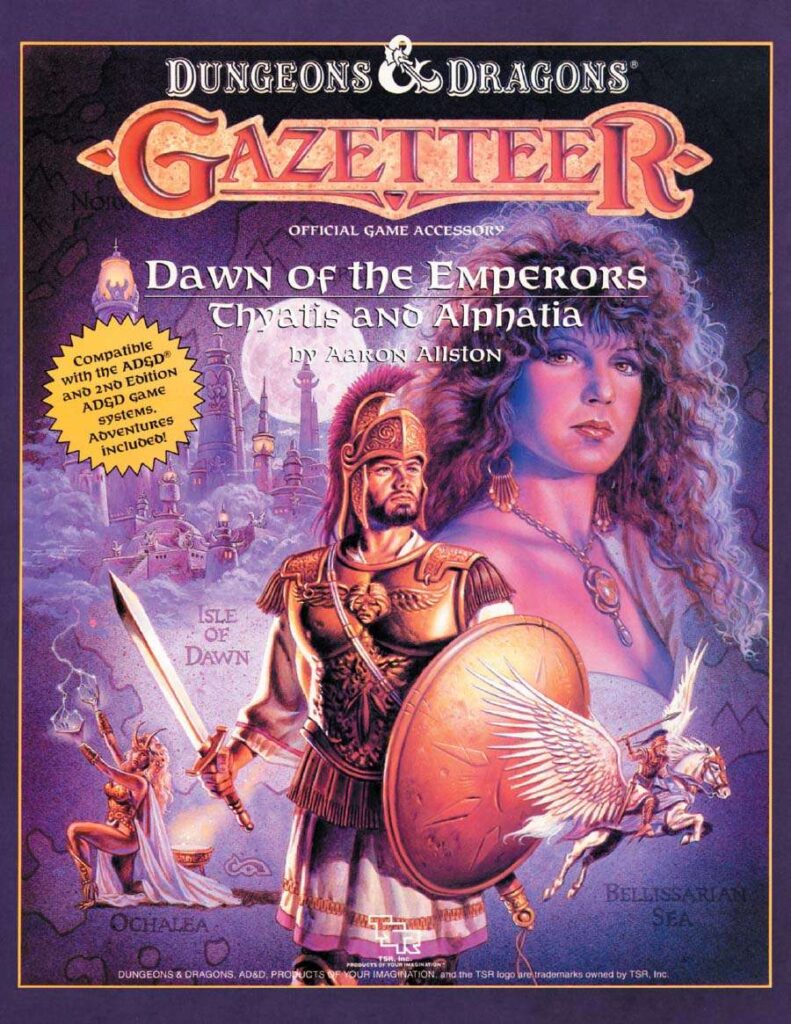Publisher: Wizards of the Coast (previously TSR)
Introduction
Dungeons & Dragons is a game of endless possibilities, where you can create and explore fantastic worlds full of magic, adventure, and wonder. One of the most beloved and rich settings of D&D is Mystara, a world that combines elements of mythology, history, and fantasy, and offers a variety of cultures, lands, and challenges for the players. Mystara was the official setting for the Basic and Expert editions of D&D, and was expanded and detailed in a series of accessories called Gazetters, each focusing on a different region or aspect of the world.
One of the most epic and ambitious Gazetters ever published was “Dawn of the Emperors: Thyatis and Alphatia”, a boxed set that was released in 1989 by TSR. The accessory was written by Aaron Allston, a renowned author and game designer, who also wrote some of the best Gazetters for Mystara, such as “The Grand Duchy of Karameikos”, “The Emirates of Ylaruam”, and “The Republic of Darokin”. The accessory had a cover by Clyde Caldwell and interior illustrations by Stephen Fabian, two of the most talented and prolific artists in the D&D industry.
“Dawn of the Emperors: Thyatis and Alphatia” is a massive and comprehensive accessory that covers the two great empires of Mystara, Thyatis and Alphatia, and their long-standing rivalry and conflict. The accessory contains a 128-page book, two 32-page books, and two large color maps. The first book, “Player’s Guide to Thyatis”, provides an overview of the Thyatian Empire, its history, geography, politics, culture, and magic. The second book, “Player’s Guide to Alphatia”, does the same for the Alphatian Empire. The third book, “Dungeon Master’s Sourcebook”, contains rules for creating characters, magic items, and campaigns in the settings of Thyatis and Alphatia, as well as descriptions of the territories disputed between the two empires, such as the Isle of Dawn, Ochalea, the Pearl Islands, and the Thyatian Hinterlands. The two maps show the lands and the seas of the two empires, with details of their cities, towns, villages, roads, rivers, mountains, forests, and other features.
The accessory is a treasure trove of information and inspiration for any D&D fan, especially those who love Mystara or are interested in exploring it. The empires of Thyatis and Alphatia are fascinating and complex, with their own strengths and weaknesses, goals and motivations, similarities and differences, conflicts and alliances. In this article, I will review the accessory and explain why it is one of the best and most influential products ever published for D&D.

The Empires of Thyatis and Alphatia
Thyatis is an empire inspired by ancient Rome, with a strong military tradition, a feudal nobility, and a senate. It is ruled by an emperor who is often challenged by ambitious rivals and foreign enemies. Thyatis is a pragmatic and expansionist empire, that values law, order, and honor, but also has a dark side of corruption, oppression, and decadence. Alphatia is an empire dominated by magic-users, who oppress the non-magical population and seek to expand their influence through conquest and colonization. It is governed by a council of powerful wizards who often clash with each other and with Thyatis. Alphatia is a visionary and innovative empire, that values magic, knowledge, and freedom, but also has a dark side of arrogance, elitism, and cruelty.
The accessory provides a detailed and nuanced description of the history, geography, politics, culture, and magic of both empires, and shows how they have evolved and interacted over the centuries. The accessory also reveals the secrets and the mysteries of both empires, such as the origins of their magic, the hidden agendas of their leaders, and the prophecy of the dawn of the emperors. The accessory also portrays the diversity and the complexity of both empires, and shows that they are not monolithic or homogeneous, but rather composed of many different regions, peoples, factions, and perspectives. The accessory also explores the similarities and the differences between the two empires, and shows that they are not entirely opposed or incompatible, but rather have some common ground and some potential for cooperation.
The accessory also depicts the conflicts and the alliances between the two empires, and shows how they have shaped and influenced the history and the destiny of Mystara. The accessory also presents the challenges and the opportunities that the two empires face in the present and the future, and shows how they are affected by internal and external factors, such as rebellions, invasions, disasters, and discoveries. The accessory also offers the possibility of changing and improving the status quo of the two empires, and shows how the actions and the choices of the players and the DMs can make a difference and have an impact on the world.

The Disputed Territories
The accessory also describes the regions that are contested between the two empires, such as the Isle of Dawn, Ochalea, the Pearl Islands, and the Thyatian Hinterlands. These regions are rich in resources, culture, and adventure, and play a key role in the plot and the gameplay of the accessory. The Isle of Dawn is a large island that is divided into several provinces, each with its own history, politics, and challenges. Some of the provinces are loyal to Thyatis, some to Alphatia, and some are independent or neutral. The Isle of Dawn is the main battleground of the war between the two empires, and the site of many intrigues, conflicts, and mysteries. Ochalea is a smaller island that is influenced by ancient China, with a feudal society, a rich culture, and a powerful dragon king. Ochalea is a vassal of Thyatis, but has a strong sense of identity and autonomy, and is often threatened by Alphatian agents and pirates. The Pearl Islands are a chain of islands that are influenced by Polynesia, with a tribal society, a colorful culture, and a connection to the sea. The Pearl Islands are independent and neutral, but are coveted by both empires for their pearls, spices, and strategic location. The Thyatian Hinterlands are the lands beyond the borders of the Thyatian Empire, such as the Savage Coast, the Serpent Peninsula, and the Hulean Basin. These lands are wild and diverse, with a variety of cultures, creatures, and dangers, and offer many opportunities for exploration, discovery, and adventure.

The accessory provides a vivid and detailed description of the disputed territories, and shows how they are affected and influenced by the two empires, and how they affect and influence the two empires in return. The accessory also reveals the secrets and the mysteries of the disputed territories, such as the ancient ruins, the hidden treasures, the legendary creatures, and the mysterious phenomena. The accessory also portrays the diversity and the complexity of the disputed territories, and shows that they are not passive or homogeneous, but rather active and dynamic, with their own interests, goals, and agendas. The accessory also explores the similarities and the differences between the disputed territories, and shows that they are not entirely isolated or incompatible, but rather have some connections and some potential for cooperation.
The accessory also depicts the conflicts and the alliances between the disputed territories, and shows how they have shaped and influenced the history and the destiny of Mystara. The accessory also presents the challenges and the opportunities that the disputed territories face in the present and the future, and shows how they are affected by internal and external factors, such as wars, revolutions, disasters, and discoveries. The accessory also offers the possibility of changing and improving the status quo of the disputed territories, and shows how the actions and the choices of the players and the DMs can make a difference and have an impact on the world.
The Rules and the Campaigns
The accessory also provides rules for creating characters, magic items, and campaigns in the settings of Thyatis and Alphatia. The rules are compatible with the Basic and Expert editions of D&D, but also introduce some new and unique features, such as:
- The social status system, which determines the rank and privileges of the characters in the society of Thyatis or Alphatia, and affects their interactions, reputation, and opportunities.
- The patronage system, which allows the characters to gain the favor and support of influential patrons, such as nobles, senators, generals, wizards, or emperors, and to receive benefits, missions, and rewards from them.
- The magic item creation system, which enables the characters to craft their own magic items, such as weapons, armor, potions, scrolls, wands, rings, or amulets, using the resources and the techniques of Thyatis or Alphatia.
- The campaign guidelines, which offer advice and suggestions for creating and running campaigns in the settings of Thyatis or Alphatia, such as themes, plots, NPCs, locations, events, and challenges.
The accessory provides a clear and comprehensive explanation of the rules, and shows how they enhance and enrich the gameplay and the storytelling of the accessory. The accessory also provides examples and illustrations of the rules, and shows how they can be applied and used in different situations and scenarios. The accessory also provides flexibility and customization of the rules, and shows how they can be modified and adapted to suit the preferences and the needs of the players and the DM. For instance, the social status system can be used to create characters with different backgrounds and goals, and to influence their interactions with NPCs and factions. The patronage system can be used to create characters with different allies and enemies, and to provide them with benefits, missions, and rewards. The magic item creation system can be used to create characters with different abilities and equipment, and to enhance their combat and exploration skills. The campaign guidelines can be used to create and run campaigns with different themes and plots, and to challenge and entertain the players and the DM. The accessory also allows the players and the DM to adjust the rules according to their own style and taste, and to create their own rules and features, using their imagination and creativity.
Conclusion
In conclusion, “Dawn of the Emperors: Thyatis and Alphatia” is an excellent and impressive accessory that deserves to be praised and appreciated by any D&D fan. It is a masterpiece of world-building, storytelling, and game design, that offers a wealth of information, inspiration, and fun for the players and the DMs. It is one of the best Gazetters ever published for Mystara, and one of the best accessories ever published for D&D. It is a classic that has influenced and enriched the gaming experience of many, and that can still do so for many more. If you are looking for an epic and immersive setting for your D&D games, or if you want to explore more of the Mystara Campaign Setting, I highly recommend you to check out “Dawn of the Emperors: Thyatis and Alphatia”. You will not regret it. 😊
Here are some recommendations and tips for using the accessory in your own games, or for exploring more of the Mystara Campaign Setting:
- If you want to play a character from Thyatis or Alphatia, you can choose from a variety of races, classes, skills, and backgrounds, such as human, elf, dwarf, halfling, fighter, cleric, magic-user, thief, gladiator, legionnaire, senator, noble, spy, merchant, scholar, or adventurer. You can also use the social status and the patronage systems to define your role and your relationships in the society of your empire, and to gain benefits, missions, and rewards from your patrons.
- If you want to create a magic item in Thyatis or Alphatia, you can use the magic item creation system to craft your own unique and powerful items, such as weapons, armor, potions, scrolls, wands, rings, or amulets. You can also use the resources and the techniques of your empire, such as metals, gems, herbs, runes, spells, or rituals, to enhance and customize your items. You can also use the secrets and the mysteries of your empire, such as the origins of your magic, the hidden agendas of your leaders, and the prophecy of the dawn of the emperors, to add flavor and intrigue to your items.
- If you want to run a campaign in Thyatis or Alphatia, you can use the campaign guidelines to create and run your own epic and immersive stories, such as wars, intrigues, revolutions, explorations, discoveries, or adventures. You can also use the themes, plots, NPCs, locations, events, and challenges provided by the accessory, or create your own, to add variety and depth to your campaign. You can also use the actions and the choices of your players and yourself, to change and improve the status quo of your empire, and to make a difference and have an impact on the world.
- If you want to explore more of the Mystara Campaign Setting, you can use the accessory as a gateway and a reference to discover and learn more about the other regions and aspects of the world, such as the Known World, the Hollow World, the Savage Coast, the Red Steel, the Immortals, the Planes, and more. You can also use the accessory as a source and a inspiration to create and expand your own regions and aspects of the world, using your imagination and creativity.
Dawn of the Emperors: Thyatis and Alphatia on Drivethrurpg
